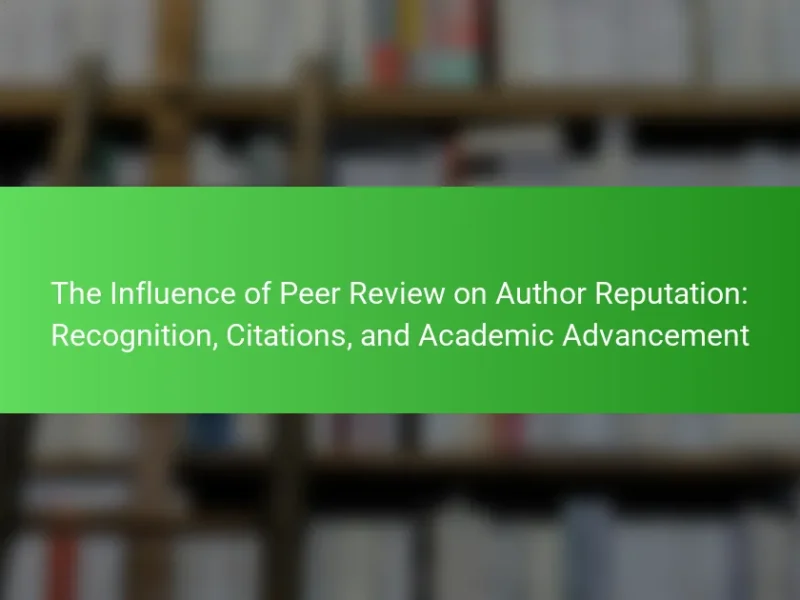Transparency in peer review is a critical component of the academic publishing process that ensures credibility and trust. This article explores the significance of transparency, detailing how it fosters clear communication regarding review processes and evaluation criteria. It highlights the benefits of transparency, such as reducing bias and conflicts of interest, enhancing reviewer accountability, and ultimately improving the quality of published research. Citing studies like that of van Rooyen et al. (2010), the article underscores the necessity of transparency for maintaining the integrity and reliability of scientific literature.

What is the Importance of Transparency in Peer Review?
Transparency in peer review is crucial for ensuring credibility and trust in the academic publishing process. It allows for clear communication of the review process and criteria used in evaluating research. When transparency is present, authors can understand the feedback and decisions made regarding their work. This openness helps to minimize bias and conflicts of interest in the review process. Furthermore, it enhances the accountability of reviewers, as their assessments can be scrutinized. Studies show that transparent peer review can lead to higher quality research outcomes. For instance, a study by van Rooyen et al. (2010) found that transparency in peer review improves the quality of published articles. Thus, transparency is essential for maintaining the integrity and reliability of scientific literature.
Why is transparency crucial in the peer review process?
Transparency is crucial in the peer review process because it fosters trust and accountability. A transparent process allows for the scrutiny of reviewers’ decisions. This scrutiny helps ensure that evaluations are fair and unbiased. Transparency also encourages constructive feedback, which enhances the quality of research. When authors know the criteria and rationale behind decisions, they can improve their work. Furthermore, transparency mitigates the risk of conflicts of interest. It allows stakeholders to assess the integrity of the research process. Studies show that transparent peer review can increase the credibility of published research. Overall, transparency strengthens the foundation of scientific communication.
What are the key elements that define transparency in peer review?
Key elements that define transparency in peer review include clear disclosure of reviewer identities, detailed reporting of conflicts of interest, and open access to review comments. Clear disclosure allows authors and readers to understand who assessed the work. Detailed reporting of conflicts of interest ensures that potential biases are acknowledged. Open access to review comments fosters accountability and allows for constructive feedback. These elements enhance trust and integrity in the peer review process, promoting fairness and objectivity.
How does transparency impact the quality of research publications?
Transparency enhances the quality of research publications by fostering accountability and trust. It allows for clearer methodologies, enabling reproducibility of results. Transparent practices include open data sharing and disclosure of conflicts of interest. These practices help prevent biases and errors in research. Studies show that transparent research increases citation rates and public trust. For example, a study published in “PLOS Biology” found that open data practices significantly improved research quality and reproducibility. Thus, transparency is crucial for maintaining high standards in scholarly communication.
What role does disclosure play in peer review transparency?
Disclosure is essential for peer review transparency. It ensures that all relevant information about conflicts of interest is available. This practice helps maintain the integrity of the review process. When reviewers disclose their affiliations and potential biases, it fosters trust in the evaluation. Transparency in disclosure allows authors and readers to assess the impartiality of the review. Studies show that transparent practices enhance the credibility of published research. For example, a 2020 analysis in the journal “Nature” highlighted that disclosed conflicts lead to more reliable peer reviews. Overall, disclosure is a key factor in achieving transparency in the peer review process.
What types of disclosures are essential in the peer review process?
Essential disclosures in the peer review process include conflict of interest, funding sources, and author contributions. Conflict of interest disclosures inform reviewers of any personal or financial interests that may bias the research. Funding source disclosures reveal the financial support behind the research, which can influence study outcomes. Author contribution disclosures clarify the specific roles of each author in the research process. These disclosures enhance transparency and trust in the peer review process. Studies show that transparency in disclosures leads to more rigorous and credible research evaluations.
How can disclosure practices enhance trust among researchers?
Disclosure practices enhance trust among researchers by promoting transparency and accountability. When researchers disclose their methods, data, and potential conflicts of interest, it allows for greater scrutiny of their work. This openness fosters a collaborative environment where findings can be verified and replicated. Studies indicate that transparency in research processes leads to increased credibility among peers. For instance, a study published in the journal “PLOS ONE” found that transparent reporting significantly improved trust in research outcomes. By adhering to disclosure practices, researchers can build a reputation for integrity, ultimately strengthening the scientific community.
How do ethics influence transparency in peer review?
Ethics significantly influence transparency in peer review by establishing standards for honesty and accountability. Ethical guidelines require reviewers to disclose any conflicts of interest. This disclosure fosters trust between authors, reviewers, and readers. Furthermore, ethical practices promote the integrity of the review process. They ensure that evaluations are unbiased and based solely on the quality of the work. Journals often adopt ethical codes to enhance transparency. For instance, the Committee on Publication Ethics (COPE) provides frameworks for ethical peer review. Adhering to these frameworks improves the overall credibility of scholarly publishing.
What ethical standards should be upheld in peer review?
Ethical standards in peer review include confidentiality, impartiality, and integrity. Reviewers must keep the identities of authors confidential to protect their privacy. They should evaluate manuscripts objectively, without personal bias or conflicts of interest. Integrity requires reviewers to provide honest and constructive feedback. These standards promote trust in the peer review process. According to the Committee on Publication Ethics (COPE), adherence to these ethical standards is crucial for maintaining the quality and credibility of scholarly publishing.
How can ethical lapses affect the credibility of research?
Ethical lapses can severely undermine the credibility of research. When researchers engage in unethical practices, such as data fabrication or plagiarism, the integrity of their findings is compromised. This leads to mistrust among peers and the public. Research that lacks credibility is less likely to be cited or used in policy-making. A study published in the journal “Nature” found that retracted papers significantly diminish the perceived reliability of scientific literature. Additionally, ethical violations can result in legal consequences and damage to the institution’s reputation. Ultimately, maintaining ethical standards is essential for ensuring the trustworthiness of research outcomes.
What are the consequences of a lack of transparency in peer review?
A lack of transparency in peer review leads to diminished trust in the scientific process. Researchers may question the validity of published studies. This skepticism can hinder collaboration and knowledge sharing. Moreover, it can result in the publication of flawed research. Flawed research can mislead future studies and clinical practices. Additionally, a lack of transparency can perpetuate biases in the review process. These biases may favor certain authors or institutions over others. Ultimately, the integrity of scientific literature is compromised.
How does a lack of transparency undermine trust in scientific research?
A lack of transparency undermines trust in scientific research by obscuring the methods, data, and motivations behind studies. When researchers do not disclose their processes, it raises questions about the validity of their findings. This opacity can lead to skepticism among peers and the public. Trust is built on accountability and openness. Without these elements, the credibility of research is compromised. Studies show that transparency in methods increases reproducibility and reliability. For instance, the “Reproducibility Project” highlighted that many scientific findings could not be replicated due to insufficient methodological disclosure. Ultimately, transparency fosters confidence in research outcomes and promotes scientific integrity.
What historical cases highlight the importance of transparency in peer review?
Historical cases such as the Andrew Wakefield study on vaccines illustrate the importance of transparency in peer review. This study, published in 1998, falsely linked the MMR vaccine to autism. The lack of disclosure regarding conflicts of interest and data manipulation led to widespread public fear and misinformation. Subsequent investigations revealed that Wakefield had undisclosed financial ties to parties involved in alternative vaccine treatments. The retraction of the paper in 2010 highlighted the need for rigorous transparency in the peer review process. Another significant case is the 2006 publication of a study on stem cells by Hwang Woo-suk, which was later found to be based on fabricated data. This incident underscored the critical role of transparency in maintaining scientific integrity and public trust. Both cases demonstrate that transparency in peer review is essential for ensuring the credibility of published research.
How can transparency be improved in the peer review process?
Transparency in the peer review process can be improved by implementing open peer review practices. Open peer review allows for the identities of reviewers to be disclosed to authors and vice versa. This method fosters accountability and can enhance the quality of reviews. Additionally, journals can publish review reports alongside accepted articles, providing insights into the review process. Some studies indicate that transparency can increase trust in published research. For instance, a 2020 study in “Nature” found that open peer review led to more constructive feedback. By adopting these practices, the peer review process can become more transparent and trustworthy.
What best practices can journals implement to enhance transparency?
Journals can enhance transparency by implementing open peer review processes. This involves sharing reviewers’ comments and authors’ responses publicly. Additionally, journals should disclose conflicts of interest for both authors and reviewers. Clear guidelines on data sharing and publication ethics are essential. Journals can also publish detailed editorial policies to inform authors and reviewers. Regularly updating these policies fosters trust and accountability. Lastly, promoting the use of preprints encourages open discussion before formal publication. These practices collectively contribute to a more transparent scholarly communication environment.
How can researchers advocate for greater transparency in peer review?
Researchers can advocate for greater transparency in peer review by promoting open peer review practices. Open peer review allows for the review process to be visible to the public. This visibility can enhance accountability and trust in the publication process. Researchers can also support journals that adopt transparent review policies. They can participate in initiatives that encourage the sharing of reviewer comments and author responses. Additionally, researchers can engage in discussions about the importance of transparency at conferences and in academic forums. By publishing articles that highlight the benefits of transparency, they can influence their peers. Collaborative efforts can lead to industry-wide changes in peer review standards. Studies show that transparency in peer review can improve the quality of published research.
What strategies can build trust in the peer review system?
Implementing transparent processes can build trust in the peer review system. Clear guidelines for reviewer selection enhance credibility. Public disclosure of conflicts of interest ensures accountability. Providing feedback to authors increases engagement and trust. Regular training for reviewers on ethical standards is essential. Utilizing open peer review models allows for greater transparency. Feedback from the community can highlight areas for improvement. Research indicates that transparency in peer review correlates with higher trust levels among researchers.
How do open peer review models contribute to trust building?
Open peer review models contribute to trust building by increasing transparency in the review process. They allow the identities of reviewers to be known, which holds them accountable for their feedback. This accountability can enhance the quality of reviews, as reviewers are less likely to provide biased or unconstructive criticism. Additionally, open peer review enables authors to respond to reviewer comments publicly. This interaction fosters a collaborative environment and demonstrates a commitment to improving research quality. Studies show that transparency in peer review can lead to greater confidence in published research. For example, a survey by the Royal Society found that 85% of researchers believe open peer review enhances trust in the review process.
What role does community engagement play in fostering trust in peer review?
Community engagement plays a crucial role in fostering trust in peer review. It encourages open dialogue between researchers and the public. This interaction helps demystify the peer review process. Engaged communities can provide diverse perspectives that enhance review quality. Transparency in feedback processes builds confidence in the integrity of reviews. Research shows that inclusive practices lead to higher satisfaction with the peer review system. Engaging stakeholders fosters a sense of ownership and accountability. This ultimately strengthens the credibility of published research.
What practical tips can enhance transparency in peer review?
Encouraging open communication among reviewers enhances transparency in peer review. This involves sharing comments and suggestions openly with authors. Implementing double-blind review processes can also reduce bias. Clear guidelines for reviewers should be established to outline expectations. Providing feedback on the review process itself promotes accountability. Encouraging the publication of review reports can increase trust in the process. Utilizing software tools for tracking revisions can improve clarity. Regular training sessions for reviewers can enhance their understanding of transparency standards.
The main entity of the article is transparency in the peer review process. The article emphasizes the critical role of transparency in enhancing the credibility, trust, and accountability of academic publishing. Key topics include the importance of disclosure regarding conflicts of interest, ethical standards that uphold integrity, and the impact of transparency on research quality. Additionally, it explores strategies for improving transparency, such as implementing open peer review practices and community engagement, ultimately highlighting how these measures can build trust within the scientific community.


